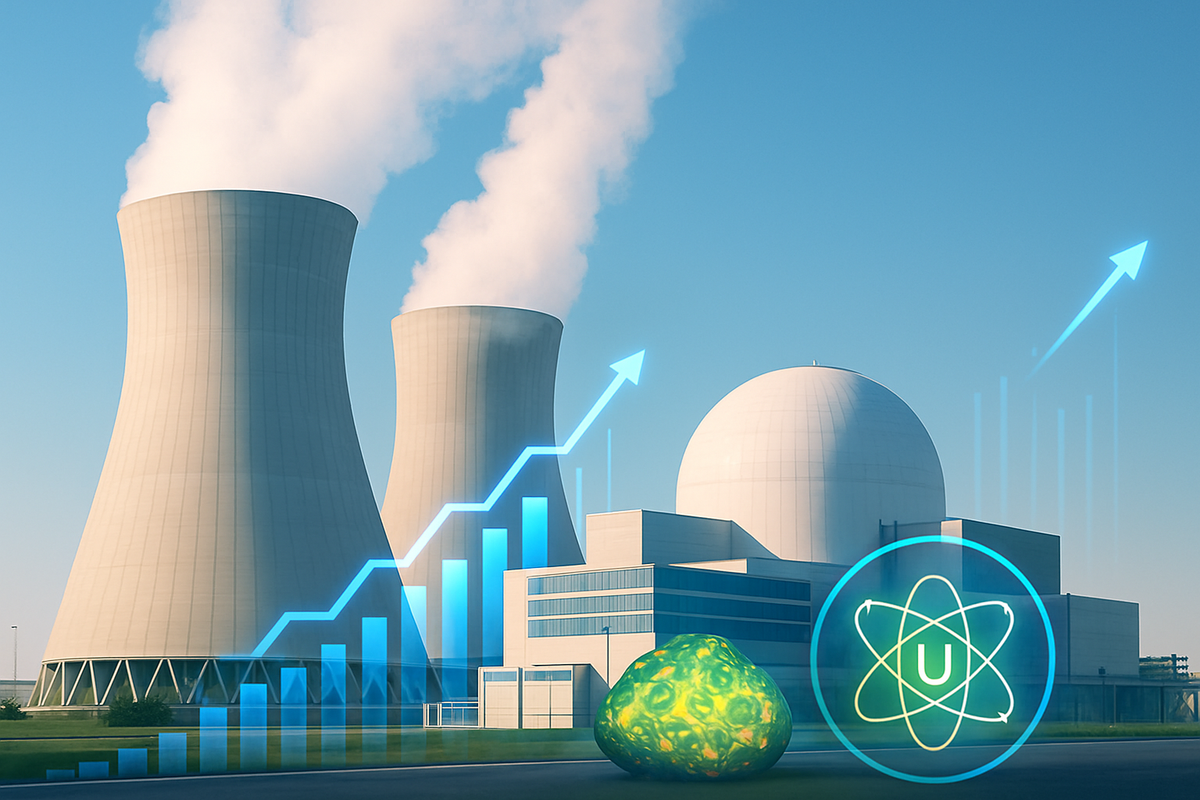
October 22, 2025 – While Denison Mines Corp. (AMEX: DNN) (TSX: DNN) experienced a slight dip in its stock price around October 21-22, 2025, a broader look reveals a significant bullish trend over the past year, underpinned by a burgeoning global nuclear energy revival. This dynamic reflects a growing investor confidence in the uranium sector, as nations worldwide increasingly turn to nuclear power to meet ambitious decarbonization goals and bolster energy security. The immediate implications for Denison Mines, a key player in Canadian uranium exploration, include heightened investor interest and strategic positioning within a tightening global uranium supply chain.
The recent movements in Denison Mines' stock, characterized by short-term fluctuations within a robust upward trajectory, are directly tied to a profound shift in global energy policy and demand. The push for cleaner energy, coupled with the immense power requirements of emerging technologies like AI, has reignited interest in nuclear power as a reliable, carbon-free baseload energy source. This resurgence is creating a "uranium boom," fundamentally altering the market landscape for companies like Denison Mines, which holds significant uranium assets in the prolific Athabasca Basin.
Detailed Coverage: The Resurgence of Nuclear and Uranium's Ascent
The narrative of Denison Mines' stock performance around October 2025 is a microcosm of the broader uranium market's complex but generally bullish outlook. While the stock saw a daily decrease of 7.34% on October 21, closing at $2.72, and a slight downturn in the two weeks prior, this short-term volatility unlies a remarkable long-term growth. In the six months leading up to October 21, 2025, Denison Mines' shares soared by an impressive 129.9%, trading near the upper end of its 52-week range of $1.08 to $3.42. This sustained growth is a direct consequence of a global re-evaluation of nuclear energy's role in the future energy mix. Investment in DNN shares surged by 417.39% in the 30 days preceding October 21, indicating strong underlying investor belief in the company's prospects.
The timeline of events leading to this moment is multifaceted. At COP28, over 20 countries pledged to triple nuclear energy capacity by 2050, signaling a decisive pivot towards atomic power as a cornerstone of their climate strategies. This commitment is supported by organizations like the International Atomic Energy Agency (IAEA), which projects a 26% increase in nuclear capacity by 2030, necessitating a substantial rise in uranium supply. Simultaneously, the U.S. Inflation Reduction Act has provided crucial tax credits for existing nuclear plants, stabilizing and encouraging their continued operation. A new and significant demand driver has also emerged: the insatiable energy appetite of AI data centers. Projections indicate electricity consumption from data centers could more than double by 2030, with AI-optimized centers quadrupling their demand, leading tech giants to explore nuclear power as a stable energy solution.
Key players and stakeholders in this revival include governments championing nuclear energy, such as the U.S. Energy Department, which announced plans in October 2025 to invest up to $500 million to boost domestic production of high-assay low-enriched uranium (HALEU). This initiative alone caused uranium miners' shares globally to jump. Major nuclear power operators like Constellation Energy (NASDAQ: CEG) and Electricité de France (EPA: EDF) are seeing renewed strategic importance. Uranium mining companies, with Denison Mines (AMEX: DNN) at the forefront, are critical to meeting future fuel demands. The initial market reaction has been a significant increase in uranium spot prices, climbing from approximately $63.50 per pound in early 2025 to nearly $79 by mid-year. This price appreciation, coupled with a looming supply shortage due to historical underinvestment and long mine development timelines, has created a robust bullish environment for the uranium sector, despite short-term market fluctuations.
Market Winners and Losers: A Shifting Energy Landscape
The nuclear revival is creating clear winners and losers across the energy sector, with uranium mining companies positioned for significant gains. Denison Mines (AMEX: DNN) (TSX: DNN), with its flagship Wheeler River project in Canada's Athabasca Basin, stands as a prime beneficiary. Its strong project pipeline and strategic focus on developing high-grade, low-cost uranium production position it to capitalize on rising demand and prices. Other major uranium producers like Cameco Corporation (TSX: CCO) (NYSE: CCJ) and Kazatomprom (LSE: KAP) are also experiencing renewed investor interest and improved financial outlooks as long-term contracts are renegotiated at higher prices and new supply agreements are sought. Junior explorers in established uranium districts are also seeing increased investment as the hunt for new deposits intensifies.
Beyond the miners, nuclear power plant operators, such as Constellation Energy (NASDAQ: CEG) in the United States and EDF (EPA: EDF) in France, are seeing a resurgence in their valuations and strategic importance. Governments are increasingly recognizing the value of existing nuclear fleets for energy security and decarbonization, leading to policy support, subsidies, and renewed investment in plant life extensions and new builds. The stability and low-carbon output of nuclear energy make these operators crucial partners in national energy strategies, attracting capital and favorable regulatory environments.
Conversely, the long-term implications could pose challenges for certain segments of the fossil fuel industry, particularly coal-fired power generation, as nuclear energy offers a cleaner and more stable baseload alternative. While natural gas may serve as a transitional fuel, the renewed focus on nuclear energy, alongside renewables, could gradually erode its market share in the power generation mix. Even some renewable energy projects, particularly those focused on intermittent sources without adequate storage, might face increased competition for investment and grid priority as nuclear power offers a constant, dispatchable carbon-free option, highlighting the need for a balanced and diversified energy portfolio.
Wider Significance: A New Era for Global Energy
The resurgence of nuclear energy and the subsequent uranium boom represent a pivotal shift in broader industry trends, signaling a global commitment to energy security and accelerated decarbonization. This event fits squarely into the narrative of a complex energy transition, where nations are balancing the urgent need to reduce carbon emissions with the imperative to maintain reliable and affordable power supplies. Nuclear power's ability to provide consistent, baseload electricity without intermittent issues, unlike some renewables, makes it an attractive solution for grid stability, especially as demand from industrial growth and AI data centers escalates dramatically. The World Nuclear Association (WNA) has consistently highlighted the critical role nuclear energy plays in achieving net-zero targets, further solidifying its place in the global energy agenda.
The ripple effects of this nuclear renaissance are far-reaching. Competitors in the energy sector, particularly those reliant on fossil fuels, will face increasing pressure to adapt or risk being marginalized as cleaner alternatives gain traction. Partners in the nuclear supply chain, from uranium conversion and enrichment services to reactor manufacturers like Westinghouse and Rolls-Royce SMR, are poised for significant growth. The renewed focus on nuclear technology is also spurring innovation in advanced reactor designs, including Small Modular Reactors (SMRs), which promise greater flexibility, safety, and reduced construction times, potentially revolutionizing the industry. Geopolitically, the secure supply of uranium and nuclear fuel is becoming a strategic imperative, leading to efforts by Western nations to reduce reliance on Russian enrichment services and bolster domestic capabilities, as evidenced by the U.S. Energy Department's HALEU initiative.
Regulatory and policy implications are substantial. Governments worldwide are likely to introduce more supportive policies, including streamlined licensing processes, financial incentives, and long-term procurement contracts to de-risk nuclear investments. Environmental regulations will continue to favor low-carbon energy sources, further enhancing nuclear's competitive edge. Historically, the nuclear industry has experienced cycles of boom and bust, often influenced by public perception, major accidents, and geopolitical events. The current revival, however, appears to be driven by more fundamental factors: climate change urgency, energy independence, and technological advancements, distinguishing it from previous cycles. Comparisons can be drawn to the initial enthusiasm for nuclear power in the mid-20th century, but with a heightened awareness of safety and waste management, alongside a global imperative for decarbonization that was absent then.
What Comes Next: Navigating the Nuclear Horizon
Looking ahead, the short-term outlook for the uranium market suggests continued volatility but with a strong underlying bullish sentiment. Uranium spot prices are expected to remain elevated, possibly pushing towards new highs, as utilities seek to secure long-term supplies in an increasingly tight market. For companies like Denison Mines (AMEX: DNN), this means continued strong investor interest and potential for accelerated development of projects like Wheeler River. In the long term, the expansion of nuclear capacity, driven by global climate goals and energy security concerns, is likely to ensure sustained demand for uranium for decades to come. New mine developments, currently hampered by long lead times and past underinvestment, will be crucial to meeting this demand, making projects with advanced development stages particularly valuable.
Potential strategic pivots for uranium miners might include increased focus on vertical integration, exploring opportunities in conversion or enrichment, or forging direct, long-term supply agreements with utilities to lock in favorable prices. Nuclear power plant operators may invest more heavily in advanced reactor research and deployment, as well as extending the operational lives of existing plants. Market opportunities will emerge in all segments of the nuclear fuel cycle, from exploration and mining to fuel fabrication and waste management. The development of SMRs could open new markets, including remote communities and industrial applications, further diversifying demand for nuclear power.
Potential scenarios include a rapid acceleration of nuclear plant construction globally, leading to a significant uranium supply deficit and even higher prices, or a slower, more measured expansion, allowing supply to gradually catch up. Geopolitical stability will also play a crucial role; any disruptions to existing uranium supply chains could trigger sharp price spikes. The increasing energy demands from AI data centers present a particularly compelling scenario, as tech companies, traditionally not major energy infrastructure investors, may directly fund or partner in nuclear projects to secure their power needs. This could introduce a new class of powerful stakeholders into the nuclear energy landscape.
Wrap-Up: A Resilient Future for Nuclear and Uranium
The recent performance of Denison Mines (AMEX: DNN) stock, despite short-term fluctuations, serves as a powerful indicator of the broader nuclear energy revival taking hold globally. The key takeaways from this event are clear: nuclear power is re-emerging as a critical component of global energy strategies, driven by urgent decarbonization goals, the imperative for energy security, and the escalating power demands of technological advancements like AI. This renewed interest is creating a robust, long-term bullish environment for uranium and the companies that supply it, fundamentally altering the dynamics of the energy market.
Moving forward, the market for uranium and nuclear energy is poised for significant growth. While volatility will likely persist, the underlying drivers for nuclear expansion—climate change, energy independence, and technological demand—are strong and enduring. Investors should assess the market with a long-term perspective, recognizing the strategic importance of nuclear power in the evolving global energy mix. Companies with high-quality uranium assets, strong balance sheets, and experienced management teams, like Denison Mines, are well-positioned to benefit from this trend.
What investors should watch for in the coming months includes continued government policy support for nuclear energy, progress on new reactor builds and SMR deployments, and any developments in the global uranium supply chain. Monitoring uranium spot and long-term contract prices will be crucial, as will tracking the financial performance and project advancements of key uranium mining companies. The confluence of environmental necessity, geopolitical realities, and technological innovation points towards a resilient and expanding future for nuclear energy, with uranium at its core.
This content is intended for informational purposes only and is not financial advice






